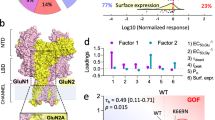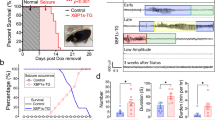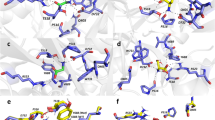Abstract
We generated mouse mutants with targeted AMPA receptor (AMPAR) GluR–B subunit alleles, functionally expressed at different levels and deficient in Q/R–site editing. All mutant lines had increased AMPAR calcium permeabilities in pyramidal neurons, and one showed elevated macroscopic conductances of these channels. The AMPAR–mediated calcium influx induced NMDA–receptor–independent long–term potentiation (LTP) in hippocampal pyramidal cell connections. Calcium–triggered neuronal death was not observed, but mutants had mild to severe neurological dysfunctions, including epilepsy and deficits in dendritic architecture. The seizure–prone phenotype correlated with an increase in the macroscopic conductance, as independently revealed by the effect of a transgene for a Q/R–site–altered GluR–B subunit. Thus, changes in GluR–B gene expression and Q/R site editing can affect critical architectural and functional aspects of excitatory principal neurons.
This is a preview of subscription content, access via your institution
Access options
Subscribe to this journal
Receive 12 print issues and online access
$209.00 per year
only $17.42 per issue
Buy this article
- Purchase on Springer Link
- Instant access to full article PDF
Prices may be subject to local taxes which are calculated during checkout





Similar content being viewed by others
References
Katz, L. C. & Shatz, C. J. Synaptic activity and the construction of cortical circuits. Science 274, 1133–1138 (1996).
Bliss, T. V. & Collingridge, G. L. A synaptic model of memory: long–term potentiation in the hippocampus. Nature 361, 31–39 (1993).
Choi, D. W. Calcium: still center–stage in hypoxic–ischemic neuronal death. Trends Neurosci. 18, 58–60 (1995).
Rothstein, J. D. & Kuncl, R. W. Neuroprotective strategies in a model of chronic glutamate–mediated motor neuron toxicity. J. Neurochem. 65, 643–651 (1995).
Hollmann, M. & Heinemann, S. F. Cloned glutamate receptors. Annu. Rev. Neurosci. 17, 31–108 (1994).
Geiger, J. R. et al. Relative abundance of subunit mRNAs determines gating and Ca2+ permeability of AMPA receptors in principal neurons and interneurons in rat CNS. Neuron 15, 193–204 (1995).
Jonas, P. & Burnashev, N. Molecular mechanisms controlling calcium entry through AMPA–type glutamate receptor channels. Neuron 15, 987–990 (1995).
Hume, R. I., Dingledine, R. & Heinemann, S. F. Identification of a site in glutamate receptor subunits that controls calcium permeability. Science 253, 1028–1031 (1991).
Burnashev, N., Monyer, H., Seeburg, P. H. & Sakmann, B. Divalent cation permeability of AMPA receptor channels is dominated by the edited form of a single subunit. Neuron 8, 189–198 (1992).
Sommer, B., Köhler, M., Sprengel, R. & Seeburg, P. H. RNA editing in brain controls a determinant of ion flow in glutamate–gated channels. Cell 67, 11–19 (1991).
Seeburg, P.H., Higuchi, M. & Sprengel, R. RNA editing of brain glutamate receptor channels: mechanisms and physiology. Brain Res. Rev. 26, 217–229 (1998).
Higuchi, M. et al. RNA editing of AMPA receptor subunit GluR–B: a base–paired intron–exon structure determines position and efficiency. Cell 75, 1361–1370 (1993).
Brusa, R. et al. Early–onset epilepsy and postnatal lethality associated with an editing–deficient GluR–B allele in mice. Science 270, 1677–1680 (1995).
Jia, Z. et al. Enhanced LTP in mice deficient in the AMPA receptor GluR2. Neuron 17, 945–956 (1996).
Wenthold, R. J., Petralia, R. S., Blahos, J. II & Niedzielski, A. S. Evidence for multiple AMPA receptor complexes in hippocampal CA1/CA2 neurons. J. Neurosci. 16, 1982–1989 (1996).
Dong, H. et al. GRIP: a synaptic PDZ domain–containing protein that interacts with AMPA receptors. Nature 386, 279–284 (1997).
O'Brien, R. J., Lau, L.–F. & Huganir, R. L. Molecular mechanisms of glutamate receptor clustering at excitatory synapses. Curr. Opin. Neurobiol. 8, 364–369 (1998).
Lin, J. W. & Sheng, M. NSF and AMPA receptors get physical. Neuron 21, 267–270 (1998).
Swanson, G. T., Kamboj, S. K. & Cull–Candy, S. G. Single–channel properties of recombinant AMPA receptors depend on RNA editing, splice variation, and subunit composition. J. Neurosci. 17, 58–69 (1997).
Swanson, G. T., Feldmeyer, D., Kaneda, M. & Cull–Candy, S. G. Effect of RNA editing and subunit co–assembly on single–channel properties of recombinant kainate receptors. J. Physiol. (Lond.) 492, 129–142 (1996).
Mosbacher, J. et al. A molecular determinant for submillisecond desensitization in glutamate receptors. Science 266, 1059–1062 (1994).
Lomeli, H. et al. Control of kinetic properties of AMPA receptor channels by nuclear RNA editing. Science 266, 1709–1713 (1994).
Burnashev, N. Calcium permeability of glutamate–gated channels in the central neurons system. Curr. Opin. Neurobiol. 6, 311–317 (1996).
Washburn, M. S., Numberger, M., Zhang, S. & Dingledine, R. Differential dependence on GluR2 expression of three characteristic features of AMPA receptors. J. Neurosci. 17, 9393–9406 (1997).
Schwenk, F., Baron, U. & Rajewsky, K. A cre–transgenic mouse strain for the ubiquitous deletion of loxP–flanked gene segments including deletion in germ cells. Nucl. Acids Res. 23, 5080–5081 (1995).
Nagy, A. et al. Dissecting the role of N–myc in development using a single targeting vector to generate a series of alelles. Curr. Biol. 8, 661–664 (1998).
Burnashev, N., Zhou, Z., Neher, N. & Sakmann, B. Fractional calcium currents through recombinant GluR channels of the NMDA, AMPA and kainate receptor subtypes. J. Physiol. (Lond.) 485, 403–418 (1995).
Andersen, P., Sundberg, S. H., Sveen, O. & Wigström, H. Specific long–lasting potentiation of synaptic transmission in hippocampal slices. Nature 266, 736–737 (1977).
Kamal, A., Biessels, G. J., Gispen, W. H. & Urban, I. J. Increasing age reduces expression of long–term depression and dynamic range of transmission plasticity in CA1 field of the rat hippocampus. Neuroscience 83, 707–715 (1998).
Gu, J. G., Albuquerque, C., Lee, C. J. & MacDermott, A. B. Synaptic strengthening through activation of Ca2+ permeable AMPA receptors. Nature 381, 793–796 (1996).
Mahanty, N. K. & Sah, P. Calcium–permeable AMPA receptors mediate long–term potentiation in interneurons in the amygdala. Nature 394, 683–687 (1998).
Dunwiddie, T. V. & Lynch, G. The relationship between extracellular calcium concentrations and the induction of hippocampal long–term potentiation. Brain Res. 169, 103–110 (1979).
Wigström, H., Swann, J. W. & Andersen, P. Calcium dependency of synaptic long–lasting potentiation in the hippocampal slice. Acta Physiol. Scand. 105, 126–128 (1979).
Horikawa, K. & Armstrong, W. E. A versatile means of intracellular labeling: injection of biocytin and its detection with avidin conjugates. J. Neurosci. Methods 25, 1–11 (1988).
Kask, K. et al. The AMPA receptor subunit GluR–B in its Q/R site–unedited form is not essential for brain development and function. Proc. Natl. Acad. Sci. USA (in press).
Kyrozis, A., Goldstein, P. A., Heath, M. J. S. & MacDermott, A. B. Calcium entry through a subpopulation of AMPA receptors desensitized neighboring NMDA receptors in rat dorsal horn. J. Physiol. (Lond.) 485, 373–381 (1995).
Kharazia, V. N., Phend, K. D., Rustioni, A. & Weinberg, R. J. EM colocalization of AMPA and NMDA receptor subunits at synapses in rat cerebral cortex. Neurosci. Lett. 210, 37–40 (1996).
Braun, R. E. et al. Infertility in male transgenic mice: disruption of sperm development by HSV–tk expression in postmeiotic germ cells. Biol. Repr. 43, 684–693 (1990).
Danielson, P. E. et al. p1B15: a cDNA clone of the rat mRNA encoding cyclophilin. DNA 7, 261–267 (1988).
Wisden, W. & Morris, B. J. in In situ Hybridization Protocols for the Brain (eds Wisden, W. & Morris, B. J.) 9–34 (Academic Press,San Diego, 1994).
Myers, S. J. et al. Transcriptional regulation of the GluR2 gene: neural–specific expression, multiple promoters, and regulatory elements. J. Neurosci. 18, 6723–6739 (1998).
Köhler, M., Kornau, H.–C. & Seeburg, P. H. The organization of the gene for the functionally dominant alpha–amino–3–hydroxy–5–methylisoxazole–4–propionic acid receptor subunit GluR–B. J. Biol. Chem. 269, 17367–17370 (1994).
Sommer, B. et al. Flip and flop: a cell–specific functional switch in glutamate–operated channels of the CNS. Science 249, 1580–1585 (1990).
Chen, E. Y. et al. The human growth hormone locus: nucleotide sequence, biology, and evolution. Genomics 4, 479–497 (1989).
Sprengel, R. et al. Importance of the intracellular domain of NR2 subunits for NMDA receptor function in vivo. Cell 92, 279–289 (1998).
Petralia, R. S., Wang, Y. X., Mayat, E. & Wenthold, R. J. Glutamate receptor subunit 2–selective antibody shows a differential distribution of calcium–impermeable AMPA receptors among populations of neurons. J. Comp. Neurol. 385, 456–476 (1997).
Cases, O. et al. Lack of barrels in the somatosensory cortex of monoamine oxidase A–deficient mice: role of a serotonin excess during the critical period. Neuron 16, 297–307 (1996).
Acknowledgements
We thank B. Sakmann and P. Andersen for discussions, R.J. Wenthold for antibodies, F. Schwenk for the deleter mouse, R. Pfeffer, A. Herold, M. Lang for technical assistance and M. Belovska, M. Kosma, S. Kranz for dendritic tree analysis. K.K. was recipient of an EMBO long–term fellowship. H.–C.K. was supported by Boehringer Ingelheim. This work was funded, in part, by grants from HFSP, the Volkswagenstiftung, the German Chemical Society and an unrestricted grant from Bristol–Meyers Squibb.
Author information
Authors and Affiliations
Corresponding author
Rights and permissions
About this article
Cite this article
Feldmeyer, D., Kask, K., Brusa, R. et al. Neurological dysfunctions in mice expressing different levels of the Q/R site–unedited AMPAR subunit GluR–B. Nat Neurosci 2, 57–64 (1999). https://doi.org/10.1038/4561
Received:
Accepted:
Issue Date:
DOI: https://doi.org/10.1038/4561
This article is cited by
-
The Q/R editing site of AMPA receptor GluA2 subunit acts as an epigenetic switch regulating dendritic spines, neurodegeneration and cognitive deficits in Alzheimer’s disease
Molecular Neurodegeneration (2023)
-
A hierarchy in clusters of cephalopod mRNA editing sites
Scientific Reports (2022)
-
A new mouse line with reduced GluA2 Q/R site RNA editing exhibits loss of dendritic spines, hippocampal CA1-neuron loss, learning and memory impairments and NMDA receptor-independent seizure vulnerability
Molecular Brain (2020)
-
Adenosine-to-inosine RNA editing in the immune system: friend or foe?
Cellular and Molecular Life Sciences (2020)
-
Widespread RNA editing dysregulation in brains from autistic individuals
Nature Neuroscience (2019)



